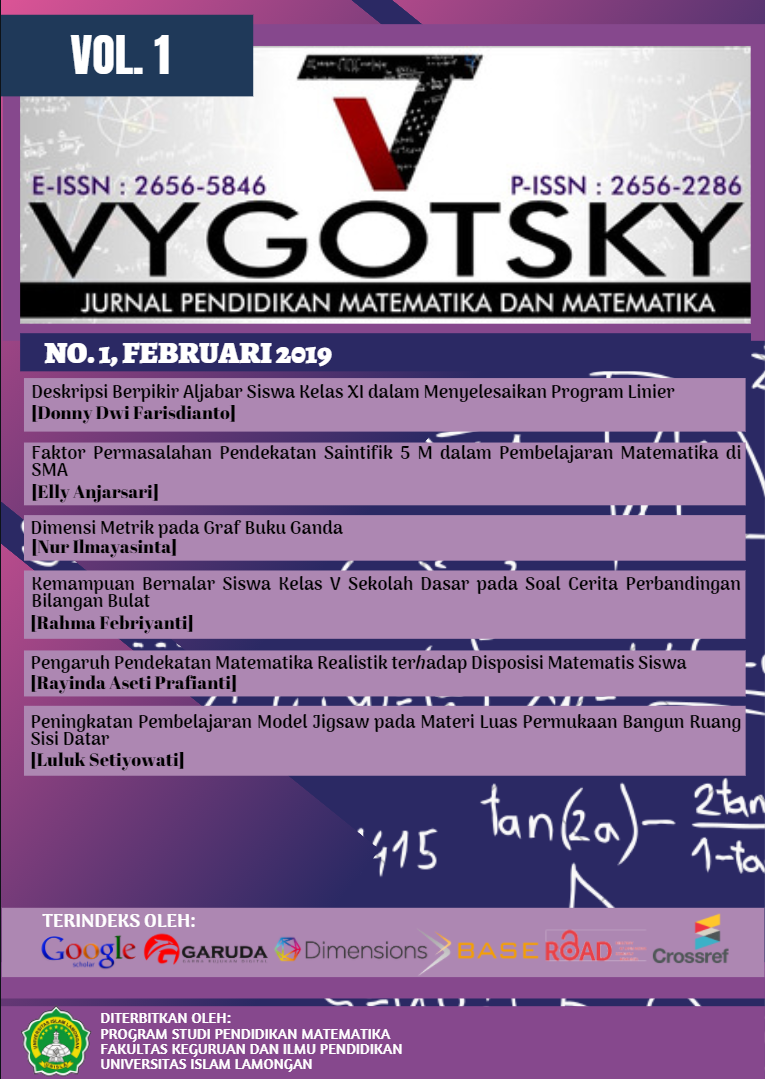Kemampuan Bernalar Siswa Kelas V Sekolah Dasar Pada Soal Cerita Perbandingan Bilangan Bulat
DOI:
https://doi.org/10.30736/vj.v1i1.90Keywords:
Penalaran, Soal Cerita, Bilangan BulatAbstract
Penalaran siswa merupakan aspek penting dalam mempelajari matematika. Penelitian ini bertujuan mengetahui penalaran siswa kelas V sekolah dasar pada soal cerita perbandingan bilangan bulat. Sampel penelitian ini yaitu siswa kelas V yang terdiri dari 20 siswa. Berdasarkan tes matematika dan tes penalaran, selanjutnya dipilih 2 siswa (1 laki-laki dan 1 perempuan) yang memiliki nilai setara sebagai subjek penelitian. Wawancara dilakukan berdasarkan tes penalaran soal cerita perbandingan bilangan bulat. Subjek perempuan memiliki kemampuan bernalar yang baik dengan menggunakan urutan bilangan. Sedangkan subjek laki-laki memiliki kemampuan bernalar yang cukup dengan menggunakan gambar dalam membandingkan bilangan bulat pada soal cerita. Hasil tersebut menyarankan sebaiknya guru melatih siswa untuk lebih mengeksplor penalarannya pada soal cerita.
Downloads
References
Bishop, J. P., Lamb, L. L., Philipp, R. A., Whitacre, I., & Schappelle, B. P. (2014). Using order to reason about negative numbers: The case of Violet. Educational Studies in Mathematics, 86(1), 39–59. https://doi.org/10.1007/s10649-013-9519-x
Bishop, J. P., Lamb, L. L., Philipp, R. A., Whitacre, I., Schappelle, B. P., & Lewis, M. L. (2014). Obstacles and Affordances for Integer Reasoning: An Analysis of Children’s Thinking and the History of Mathematics. Source: Journal for Research in Mathematics Education, 45(1), 19–61. https://doi.org/10.5951/jresematheduc.45.1.0019
Bofferding, L. (2014). Negative Integer Understanding : Characterizing First Graders ’ Mental Models. Journal for Research in Mathematics Education, 45(2), 194–245. https://doi.org/10.5951/jresematheduc.45.2.0194
Charles, R. I. (2005). Big ideas and understandings as the foundation for elementary and middle school mathematics. Journal of Mathematics Education Leadership, 7(3), 9–24. Retrieved from http://www.btschools.org/154110830215321660/lib/154110830215321660/NCSMJournal_Big_Ideas.pdf
Conner, A. M., Singletary, L. M., Smith, R. C., Wagner, P. A., & Francisco, R. T. (2014). Identifying Kinds of Reasoning in Collective Argumentation. Mathematical Thinking and Learning, 16(3), 181–200. https://doi.org/10.1080/10986065.2014.921131
Febriyanti, R. (2016). Profil Pemecahan Masalah Matematika Siswa dalam Menyelesaikan Soal Cerita Ditinjau dari Perbedaan Jenis Kelamin. Jurnal Ilmiah Pendidikan Matematika, 2, 81-89.
Febriyanti, R. (2018). The Way of Students ’ Reasoning of Elementary Students in Solving Integer Problem The Way of Students ’ Reasoning of Elementary Students in Solving Integer Problem. Journal of Physics: Conference Series, 1108. https://doi.org/10.1088/1742-6596/1108/1/01033
OECD. (2014). PISA 2012 Results: Creative Problem Solving: Students’ Skills in Tackling Real-Life Problems. (Online). (http://www.oecd.org/pisa/keyfindings/pisa-2012-results-volume-v.htm/, diakses pada 30 Januari 2019).
Stephan, M., & Akyuz, D. (2012). A Proposed Instructional Theory for Integer Addition and Subtraction, National Council of Teachers of Mathematics, 43(4), 428–464.
Whitacre, I., Azuz, B., Lamb, L. L. C., Bishop, J. P., Schappelle, B. P., & Philipp, R. A. (2017). Integer comparisons across the grades: Students’ justifications and ways of reasoning. Journal of Mathematical Behavior, 45, 47–62. https://doi.org/10.1016/j.jmathb.2016.11.001
Whitacre, I., Bishop, J. P., Lamb, L. L. C., Philipp, R. A., Schappelle, B. P., & Lewis, M. L. (2012). Happy and sad thoughts: An exploration of children’s integer reasoning. Journal of Mathematical Behavior, 31(3), 356–365. https://doi.org/10.1016/j.jmathb.2012.03.001
Downloads
Published
How to Cite
Issue
Section
License
Copyright:
Authors who publish their manuscripts in this Journal agree to the following conditions:
- Copyright of any article on Vygotsky: Jurnal Pendidikan Matematika dan Matematika is held solely by the author under the Creative Commons Attribution 4.0 International license (CC BY NC SA).
- Authors can submit papers separately, arrange non-exclusive distribution of manuscripts that have been published in this journal into other versions (e.g. sending to the author's institutional repository, publication in a book, etc.) by acknowledging that the manuscript has been published for the first time in Vygotsky: Jurnal Pendidikan Matematika dan Matematika.
License:
Vygotsky: Jurnal Pendidikan Matematika dan Matematika is published under the terms of the Creative Commons Attribution 4.0 International License (CC BY NC SA). This license permits anyone to copy and redistribute this material in any form or format, compile, modify and develop this material for any purpose as long as it is not for commercial purposes. Additionally, anyone must provide credit and distribute contributions under the license of the creator of the original work.











